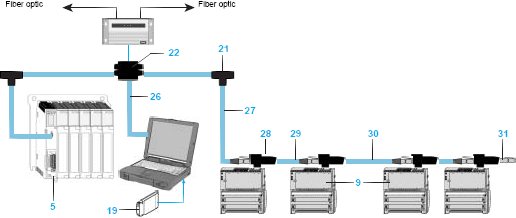Common Installation Mistakes on Modbus Plus Networks
Courtesy of: Delta Automation, Inc.
History | Specifications | Modbus Organization">Modbus Plus is a robust network of peer to peer communications used on process control and data acquisition applications, but several basic mistakes are commonly uncovered during the certification process performed by Delta Automation, Inc.'s Field Service Engineers.
One, if not the, most frequent, is exceeding the maximum allowable limit of 1500 cable feet without a repeater. Modbus Plus is a continuous cable with four conductors, a twisted pair, a drain wire and a shield. You must use the approved shielded Belden cable for the network to perform properly.
There are several types of connectors approved for node connections, they are: the MBKT type, the TEE type, the Ruggedized Industrial type and the newest Version, which utilizes screw terminals. However; you cannot mix the MBKT style with any of the type connectors which utilize the drop cable (all others). The grounding scheme is quite different.

Â
There are two lengths of drop cables, 8 and 20 feet that are connected to all but the MBKT type connectors. These add 16 or 40 feet respectively to the main Modbus Plus or “trunk†cable. Using the connectors which have drop cables guarantees the 10 feet minimum between nodes unless someone shortens the drop cable.
Orientation of these connectors is critical for proper grounding. If you terminate on the "left"Â side of one end of a segment you must follow the same pattern of coming in on the "left and going out on the right"Â so the other end of the segment is terminated on the "right"Â side. This will insure each piece of the main cable is grounded properly.
The Industrial taps cause an impedance mismatch which can be displayed as an insertion reflection when testing the network using a time domain reflectometer (TDR). Delta Automation, Inc. does not recommend more than two of these taps on any segment. The MBKT connectors are "daisy-chained"Â together so when a node is connected or disconnected, the main trunk may be disturbed or made intermittent. This also may cause a poor connection at the MBKT, which in turn changes the resistance of the network that adversely effects the communications. A quick check of a segment is to measure the resistance between pins 2 and 3. The reading should be between 60-80 ohms, if both ends are terminated properly and the 1500-foot length has not been exceeded. Any additions to your Modbus Plus networks or new networks can be certified by Delta Automation, Inc. Engineers. This certification includes a written report with the TDR printout as a snapshot of your network detailing node distances and any problems located and repaired.